Mark Sisson's Blog, page 318
November 23, 2013
Cornish Game Hens with Egg and Sausage Stuffing
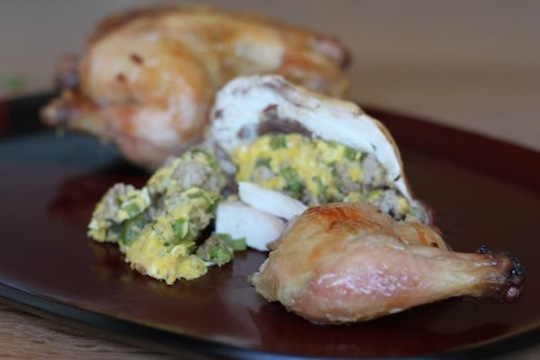
Turkey is a tricky bird to cook, requiring elaborate brining and seasoning rituals and a few Hail Marys to turn out moist and flavorful meat. Whether it’s for Thanksgiving or some other festive meal, you can take the pressure off by ditching the turkey for a smaller, moister and quite elegant little bird, the Cornish game hen.
Cornish game hens are single-serving birds that roast in an hour or less. In this recipe the hens are simply seasoned with butter, salt and pepper then stuffed with a rich and satisfying blend of eggs, sausage and herbs. This meaty stuffing makes regular old bread stuffing seem like a stale substitute.
Your guests will be thrilled to have their own individual bird, especially when they discover the delicious stuffing hidden inside. Served with all your favorite holiday sides, it’s a stress-free meal that will leave everyone full and happy.
Servings: 4
Time in the Kitchen: 1 1/2 hours
Ingredients:

4 Cornish Game Hens
1 pound ground pork (450 g)
1 teaspoon fennels seeds (5 ml)
1/4 cup finely chopped parsley (60 ml)
1 tablespoon finely chopped fresh sage (15 ml)
4 tablespoons unsalted butter, divided (60 ml)
1 leek, thinly sliced
1 cup thinly sliced celery (150 g)
4 eggs, whisked
Instructions:
Preheat oven to 425 °F (218 °C).
Pat the game hens dry. Set aside.
Over medium-high heat brown the sausage with the fennel seeds, breaking the meat up into small pieces as it cooks. Season the meat with salt, pepper, parsley and sage. Transfer the cooked meat into a large bowl and set aside.

If there is not enough pork grease left in the pan, then melt 1 to 2 tablespoons of butter. Add the leek and celery and saute until the veggies begin to soften, about 8 minutes. Add the eggs, stirring just enough to scramble the eggs until they are cooked through.

Mix the eggs with the meat.
Melt the remaining 2 tablespoons of butter. Rub the melted butter all over the birds and season lightly with salt and pepper.
Stuff each bird with the egg and meat mixture.

**Note that there might be some stuffing leftover, but if your hands have touched the raw hens then dipped into the bowl of stuffing, you won’t want to eat the extra stuffing. To avoid this, set 1 cup of the stuffing aside and use it only if needed to add more stuffing to the birds.
Pull the flaps of fat at the tail end of the hens over the open cavity and skewer closed with toothpicks. Tuck wing tips under or cut them off.
Roast the Cornish game hens on a rack in a roasting pan that’s large enough so the birds aren’t touching.

Roast for about 1 hour until cooked through and a thermometer inserted into the thigh and into the center of the stuffing in the cavity reaches 165 °F (74 °C).

Stuffing Safety Tips
Do NOT stuff the birds early and let them sit around before roasting, even if you store them in the refrigerator. Only add the stuffing immediately before roasting the birds.
Ideally, the egg and sausage mixture should still be warm or hot when you stuff it into the hens. This helps the stuffing quickly heat up to a safe temperature in the oven, reducing the risk of bacteria growth.
Make sure the temperature of the stuffing in the middle of cavity reaches 165 °F (74 °C) before taking the hens out of the oven.
Not Sure What to Eat? Get the Primal Blueprint Meal Plan for Shopping Lists and Recipes Delivered Directly to Your Inbox Each Week

November 22, 2013
My Transition from an Ill, Frail, Anemic College Student to a Healthy, Strong, and Fit Individual
It’s Friday, everyone! And that means another Primal Blueprint Real Life Story from a Mark’s Daily Apple reader. If you have your own success story and would like to share it with me and the Mark’s Daily Apple community please contact me here. I’ll continue to publish these each Friday as long as they keep coming in. Thank you for reading!
 It was painful to wake up in the morning; I just didn’t think I’d have energy again.
It was painful to wake up in the morning; I just didn’t think I’d have energy again.
During the summer of graduating high school (2011) I had wisdom teeth surgery. I had two teeth extracted and was in excruciating pain for days. My mouth later became infected and it was difficult to swallow. During the first few days I could barely eat or drink anything. I am five feet tall (short and proud of my tiny size) and at this time I weighed 121 pounds. My parents noticed how I seemed to drop a few pounds. Initially it bothered me because I am an athlete, a tennis player, and I thought I was losing muscle. Anyways, after five days since my tooth surgery I stepped on the court with barely anything to eat or drink and a swollen mouth. I managed to play the best tennis I played at the time and moved so effortlessly. I realized that those few pounds allowed me to be lighter on my feet. So, after recovering from the surgery I continued to eat smaller portions and transitioning into college that year and being on the tennis team I continued to eat smaller portions (one plate during meals in the dining hall: no pizza or fried foods either) and worked out about two hours a day with lifts twice a week. I dropped about 14 pounds from late June to December that year (weighing in at 106.5 pounds). That next semester I dropped an addition three pounds (103.5 pounds). I didn’t realize that when I started that weight loss journey I was so pudgy to begin with, but I liked what I saw in the mirror and I felt so much better about myself with that weight loss.

Left: Junior year of high school; Middle: Senior year of high school (prom); Right: Senior year of high school
When I came home for the summer of my freshman year I hit a plateau and was frustrated with the stalling of weight loss. I decided to drastically cut my calorie count and micromanage exactly what I consumed. At this point I was still consuming the Standard American Diet and relied heavily off oatmeal and cereal and whole grains. With the drastic calorie cut, I started to beat that plateau. In addition, I worked out more intensely than ever between playing tennis and running for 40 minutes or lifting daily. I started to become over trained. My whole body and brain became fatigued. I initially took it as that I was just working out a lot and I tried to forget about being tired. But, coming into sophomore year of college those symptoms never went away, only simply getting worse. At this point I was down 24-25 pounds (96-97 pounds).
I could barely walk to class without becoming winded and tried to give 100% at the 2-hour a day tennis practices but could barely provide 50%. My body was dying on me and I was miserable. As much as I couldn’t perform up to par for tennis, my relationship with my boyfriend was failing as well. I just wasn’t the same and my poor energy levels were affecting every aspect of my life. I finally decided to seek help and go to the student health center on campus. This process began towards the end of the fall season (late September 2012). I began getting blood work treatments in attempts to diagnose what was wrong. Blood taken ranged from four test tubes of blood to a whopping 14 test tubes. I was at first diagnosed as anemic. Causes of the anemia were unidentified. More rounds of blood work indicated my liver enzymes were extremely high, but yet again no cause to that. During this whole time frame (September-November 2012), I was extremely frail, fatigued, no energy, vulgar flatulence, low libido, and bad stomach pains. I honestly didn’t think I was ever going to have energy again. I also dropped 31-32 pounds by this point. I was at my lowest weight of 89-90 pounds. I weighed myself daily and when on the days the scale read 89, I was frightened.
The fall tennis season ended late October and I knew I needed to rest. I only worked out about four times a week for 30 minutes or less whether it was tennis or running. It hurt to wake up in the morning and I slept early at night. I was always in a bad mood since I had no energy to do anything. I just tried to keep up with my classes at that point. Without any reason for my viral infection, by mid-November I started to have some energy. It came in bursts but it was progress. Also, I managed to receive my highest GPA that semester somehow. By winter break, I began to work out daily whether it was an hour of tennis or 1-3 miles running. Although, I still had extreme flatulence, bloating, and stomach pains. I also was at a weight of 91-92 pounds.
By the end of January (2013), I started my Paleo transition. One afternoon at college, I consumed a bowl of Kashi granola cereal. Within literally a minute the extreme flatulence started. I was puzzled, yet eager to realize what exactly caused that. After some Internet searches, I realized a particular ingredient in the cereal causes extreme flatulence in some individuals. That research led to the anti-grain articles and Mark’s Daily Apple. I decided I had nothing to lose and gave up grains the next day. That next day was an absolute epiphany for me. I encountered zero stomach pains, no bloating, absolute no gas, and my bowels started to move. In addition I don’t think I had so much energy in many months. I decided that was it and I started to really improve.

Left: Fall Semester sophomore year of college (lowest weight); Middle: winter break of sophomore year (also lowest weight); Right: August 2013 (currently) at a healthy, fit weight
Despite being strict on anti-grains and continual Paleo research, I had severe sugar cravings. Part of it was the tennis practices and the other was nutrient deficiencies and my body was craving instant energy. So I binged…a lot on cookies, brownies, fudge, ice cream, candy, etc… Other than that I was strictly grain free.
Well, in June of 2013 I decided to cut out dairy. Between January and June the cravings were unreal and my mood varied constantly and I would be so upset with myself for binging and getting cravings. As hard as it was I made baby steps. I said enough was enough and I need to be healthy and happy for myself. If I wanted a long, successful life I needed a healthy mind and the grains/dairy were not providing any of that for me. After deciding to completely cut out dairy, the cravings started to subside. I began consuming loads of meat, fruit, coconut, nuts, veggies, and most importantly BACON.
I realized that the dairy/grains were affecting my hormones, mood, anxiety, stress levels, stomach pains, etc… leading to food allergies/intolerances. Paleo is truly the cure to all of my past issues and viral infection. Paleo has allowed me to have stable high energy levels, minimal flatulence, minimal cravings, and healthy digestion. With the help of Mark’s Daily APple and my curiosity I have truly become healthy, happy, and fitter than ever. Since my lowest weight I have put on three pounds of lean muscle and have dramatically increased my stamina. I have decided to no longer compete collegiately for tennis and instead reduced my amount of exercise to 20-60 minutes a day whether it’d be tennis or running. I have also introduced daily Intermittent Fasting and my hunger has normalized/reduced. I now will eat breakfast (got to get my eggs and bacon in), a mid-morning snack, and lunch. I no longer eat in the late afternoon/evening which allows me to sleep like a baby every night. I have reduced my net carb count to about 100 grams or less and that also contributed to the stable mood/hormone levels. The decreased amount of physical exercise and the addition of eating Paleo allowed my body to comfortably function day-to-day and maintain high energy/mood. In addition, my relationship has improved dramatically with my boyfriend and I now feel back to normal (actually even better than normal!). I realized that this lifestyle (NOT JUST A DIET) worked wonders for my life.
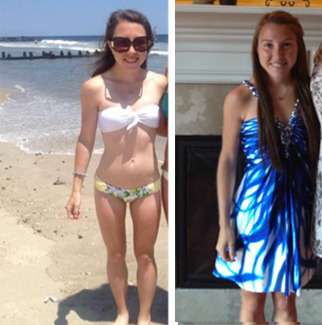
Left: Beach July 2013 also had a healthy fit weight; Right: August 2013 at a family wedding, again at a healthy, fit weight (big difference since high school)
I’d like to thank your blog and all your vital information that has helped me through my transition from an ill, frail, anemic college student to a healthy, strong, and fit individual. This has been such a long process for me, but it has been well worth it and couldn’t be happier with who I am today: a tiny, but mighty, tennis player, runner, and college student. Grok on!
~Katrina
Like This Blog Post? Dig Deeper with Primal Blueprint Books and Learn How You Can Reprogram Your Genes to Become Leaner, Stronger and Healthier

Grok Decals Now Available (plus a Special 1-Day Offer)
 Just a quick announcement before today’s regularly scheduled Primal Blueprint Real Life Story:
Just a quick announcement before today’s regularly scheduled Primal Blueprint Real Life Story:
Many of you have been asking for these for quite a while, so I’m pleased to say they’re finally available. It’s a Grok Decal that you can stick on your car window or any other flat surface to tell the world you’re Primal. The decal comes with the slogan “Live Long. Drop Dead.,” which, if you’re a long time reader of Mark’s Daily Apple, you’ll know as a common refrain around here. As I say, it’s all about living a long, healthy, active and vibrant life all the way up to the very end. You can sport the decal with the slogan, or simply clip it off and have Grok go solo as shown in the photo below.
They’re only $4.95 and I’ll cover the cost of shipping and handling. You can get them here.
Or, for today only, order anything else on PrimalBlueprint.com (apparel, book, nutrition supplement, etc.) that’s $10 or more, and you’ll get one for free. (Fine Print: No coupon code necessary. The decal won’t show up in your shopping cart, but will be included with your shipment if your online order is placed on Nov. 22 PST. One free decal per customer. Any questions? Call 888-774-6259 (or 310-317-4414)) Enjoy!
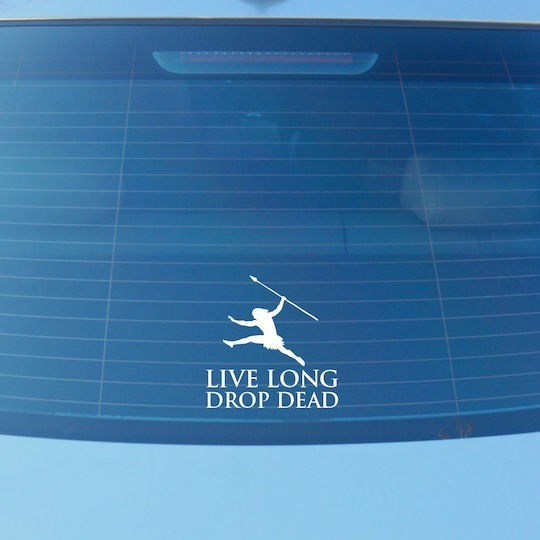
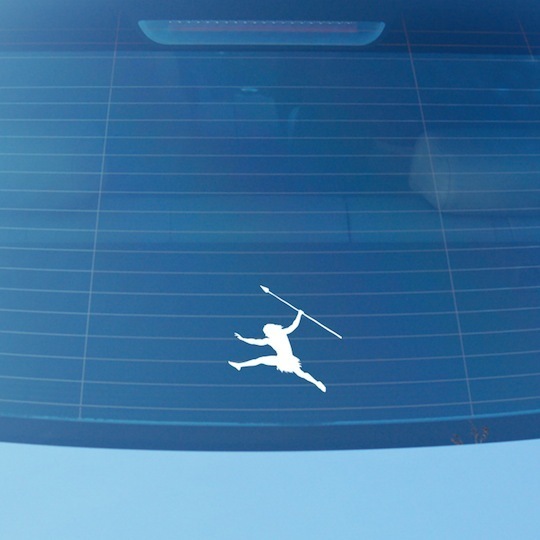

Order Your Grok Decal Today!

November 21, 2013
A Midweek Kick in the Pants
 Every Friday I love highlighting stories about men and women who took the challenge and transformed their lives. Whatever their circumstances (e.g. diabetes, obesity, chronic autoimmune conditions), they grabbed hold of the Primal process and made it their own. Whether they went cold turkey or began in fits and starts, they eventually committed 100% and got the life they wanted. It doesn’t get any better than that. That’s why I wonder so much about folks who come to MDA on a regular basis but never really get so far as to implement the content in their own lives. Whether it’s information about low (or even moderate) carbing, moving frequently, standing workstations, going barefoot or relishing good natural fat, their interest never translates into action.
Every Friday I love highlighting stories about men and women who took the challenge and transformed their lives. Whatever their circumstances (e.g. diabetes, obesity, chronic autoimmune conditions), they grabbed hold of the Primal process and made it their own. Whether they went cold turkey or began in fits and starts, they eventually committed 100% and got the life they wanted. It doesn’t get any better than that. That’s why I wonder so much about folks who come to MDA on a regular basis but never really get so far as to implement the content in their own lives. Whether it’s information about low (or even moderate) carbing, moving frequently, standing workstations, going barefoot or relishing good natural fat, their interest never translates into action.
I’ll call them earnest lurkers. They’re regular readers and enjoy the community here, but somehow the rubber never meets the road. Sound familiar? (No need to slink back in your chair – seriously.) They enjoy what they read, but then they sort of ignore/forget about it and go back to doing the same old thing. So, they come back for more inspiration and a few more ideas. So armed, they muster up a little more resolve but then never quite get things off the ground. It becomes an ongoing passive cycle. Maybe they’re doing some parts right like surrounding themselves with positive influences (e.g. the MDA community) and learning about how to live healthily – Primally. Yet, they never really make the plunge and stay content to dabble.
You’ve of course heard the old saying about “&%@# or get off the pot.” I’m not suggesting anyone stop reading MDA or not look to this forum or other like-minded communities for support and inspiration. However, there’s a certain confusion about one’s intent if you keep coming back for something you never take on. What’s keeping you at a polite (and thoroughly ineffective) distance?
I think people in this situation often run the risk of self-identification by mere association. In other words, you can read about something for so long that you end up feeling like you’re a true blue follower even though you’re more of a passive onlooker. Although I appreciate anyone’s readership, the fact remains that the Primal Blueprint doesn’t happen by osmosis. Ultimately, it’s a crying shame because instead of nodding in agreement, you could be feeling amazing at this very minute. The PB isn’t an intellectual exercise. It’s a blueprint for living, and either you’re living it – or you’re not.
Let me say I’m not picking on anyone. The truth is, I think we all at some point in our lives need a swift kick. For whatever reason there’s a psychic blockage that we can’t snap ourselves out of. After weeks or months or years (or decades) of denial, someone calls us out in a way that first gets our dander up but ultimately shifts the ground enough for real change.
Nor am I talking about unquestioning compliance with every suggested activity.
As someone who devoutly questions authority, I don’t ever encourage obedience just on principle. (That’s why I designed a blueprint and not a regimen.) What I’m talking about is grabbing the ball and running with it instead of sitting in the stands time and again watching it go from place to place – observing other people’s game instead of pursuing your own. What’s the point, really?
At the heart of this hemming and hawing or general passivity lurk a few motivations, I believe. Sure, one can be sheer laziness: I want to show up and enjoy the community but not do the actual work. The thing is, those people eventually seem to float elsewhere over time. If you’re reading but consistently coming back, I think there’s something deeper at play. Call it self-directed stone-walling, an inward withholding from yourself – of better health and a better life.
Address whatever is going on – the nonsense about I’m not capable or I don’t deserve the good life in the same way other people do or it’s never really going to happen that way for me. Bull. Dump the self-defeating attitude. Resolve to end the self-sabotage. (Seriously, accept it for that.) Analyze it if you will, but the point is to move on even if you have to fake it until you make it. Fake the confidence if you don’t feel quite worthy. Fake the motivation if you feel (or even know) that you’re 100% lazy. Fake the self-image if you think on some subterranean level that you shouldn’t and won’t ever be thin/healthy/successful/happy. Faking it will at times hurt. It will take energy. It might even take more energy than working out and lifting the chopping knife to make yourself that Big A$$ Salad you’ve always meant to make for lunch. No matter. Work your own sense of worthiness or optimism or diligence as a muscle, and expect the same stress, fatigue and progress along the way.
So, have we cast every phantom excuse into the light of day? What’s left that’s keeping you hiding or distant? Are you willing to put it out there on public display? (Trust me, it will feel good having done it.)
By all means, read. Visit. Chat. But more than any of that, manifest. No one can do this part for you, but everything meaningful hinges on it. Make yourself a Primal plan every single day if you have to. What am I going to do today to get my butt in the game? Bring some chicken thighs and cut vegetables for lunch? Get sun over the weekend instead of sit inside? Hit the gym on the way home? Practice a mini power outage and be coaxed into a natural bedtime? Then do it. The next day, do it some more. Start edging out all the garbage that doesn’t work for you in your life and health. Come back for more ideas to elbow out more still. Nod less. Do more – today of course.
Anyone willing to admit being in the hot seat today? What’s been holding you back from taking the plunge? What’s the first thing you’re going to commit to right now? Does this ring true of your past with the PB? If so, what gave you the swift kick to get going? Looking forward to reading your thoughts… Thanks for stopping by today, everyone.
Have You Seen the New Primal Book? Discover The Hidden Plague and the Special Offer That Expires on Nov. 30

November 20, 2013
Blue Light: Better Than Coffee?
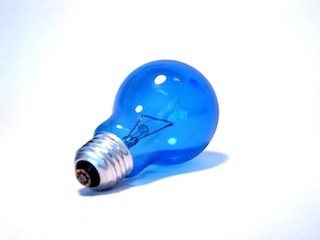 For years now, across multiple posts here on Mark’s Daily Apple, nighttime blue light has gotten a pretty bad rap. Although I’ve mentioned that blue light during the day is important (and natural sunlight is helpful), I haven’t focused on it, mostly homing in on the circadian-disrupting, sleep-inhibiting, melatonin-blunting effects. As a result, many of you may be entirely unaware of the potential positive, beneficial applications of blue light. Recent and not-so-recent research has confirmed that blue light can actually improve our cognitive abilities, including memory, alertness, reaction time, and executive function – at least in the short term. Oh, and it doesn’t always ruin our sleep. It might even improve it if you expose yourself at the right time.
For years now, across multiple posts here on Mark’s Daily Apple, nighttime blue light has gotten a pretty bad rap. Although I’ve mentioned that blue light during the day is important (and natural sunlight is helpful), I haven’t focused on it, mostly homing in on the circadian-disrupting, sleep-inhibiting, melatonin-blunting effects. As a result, many of you may be entirely unaware of the potential positive, beneficial applications of blue light. Recent and not-so-recent research has confirmed that blue light can actually improve our cognitive abilities, including memory, alertness, reaction time, and executive function – at least in the short term. Oh, and it doesn’t always ruin our sleep. It might even improve it if you expose yourself at the right time.
Wait a minute – blue light is good for us? Sisson, you just got done spending the last few years telling me to excise blue light from my vicinity at night if I wanted a good night’s sleep, and now you’re saying we might actually need more blue light. What gives?
Easy. Context is everything. Blue light at night can have a negative, inhibitory effect on our sleep onset and sleep quality because it signifies daytime to our suprachiasmatic nucleus, that region of the hypothalamus that sits near the optic nerves and regulates our circadian rhythm according to the light we perceive. But during the day – you know, when blue light naturally bounces around the atmosphere into our eyes – it’s beneficial because presence of blue light matches up with our bodies expectations. Blue light isn’t “bad,” in other words. It’s bad in the wrong context. In the right context, which is daytime, blue light promotes restful, satisfying nighttime sleep.
And for the exact same reasons blue light is bad for melatonin secretion and sleep physiology when we’re exposed at night, it also provides a boost to cognition. The bulk of the blue light research may focus on its inhibitory effects on melatonin and sleep, but a growing body of study is realizing that those same inhibitory effects seen at night can be used to improve alertness, executive function, memory, and other aspects of cognition. What’s negative at night when you’re trying to sleep is helpful or even essential when you’re trying to get work done. Blue light may very well be better than (or at least equal to) caffeine.
Let’s look at a few recent studies to see how we might use blue light to our advantage.
In this 2011 study, LED backlit computer screens enhanced cognitive function to a greater extent than non-LED backlit screens. Sustained attention, working memory, and subjects’ ability to learn words were all enhanced in the LED group. Both screen types emitted light of the same wavelength, but the LED screens’ light was over twice as intense.
A recent study (PDF) compared the effects of caffeine and blue light on psychomotor function (the interface between cognition and physical movement) and found them both to be positive but distinct from one another. Subjects exposed to blue light performed best on tests of executive function that included a distraction; the same distraction proved too distracting for caffeine users, who fared more poorly. Both groups performed well at a Go/No-Go test, which assesses sustained attention.
Even visually-blind people with “non-image-forming photoreception” (the ability to sense light) derive cognitive benefits from blue light exposure, according to a recent, very cool study. fMRI tests confirmed that brief exposure to blue light “triggered the recruitment of supplemental prefrontal and thalamic brain regions involved in alertness and cognition regulation.”
Still, the best way to get your blue light is probably through natural daylight. A 2011 study (PDF) out of Switzerland compared the cognitive effects of daytime natural light and daytime polychromatic (which includes blue) artificial light. Subjects were exposed to six hours of either light source from noon onwards and subjected to a test measuring executive control. The natural light group was more accurate and made fewer errors. Melatonin secretion were similar in both groups even though the natural light group was more alert.
Cognition-enhancing blue light during the day also has the likely effect of improving sleep at night. In 2008, researchers improved alertness and productivity in office workers by switching out their standard fluorescent white overhead lights for blue-enriched white lights. Blue-exposed workers performed better, which was expected, but they also slept better at night (which undoubtedly helped performance).
Not bad, eh? Makes a guy want to step outside and get some fresh air. Or, barring that, stare straight into an LED bulb.
Things to keep in mind when applying these results to your workday:
Use an LED. Most of the studies used basic LED lights. Others may work, but we know LEDs work. The caffeine/blue light study used a 3-watt, 470 nm, 40 lux RGB LED bulb, similar to this $2 one from eBay. This is another option.
Or download a blue light therapy app for your smartphone. iOS has Blue Light Therapy and Android has Blue Sleep Therapy. Turn the brightness up.
It doesn’t take much exposure to get an effect. Although the caffeine study used hour-long light exposure times to match the known duration of effect of caffeine in the body, other research has shown changes to brain function with just 50 seconds of blue light exposure.
Get blue light freely during the day. We’re supposed to get lots of blue light during the day (natural daylight is filthy with it), and the research is pretty unequivocal: blue light exposure enhances cognition and alertness during the day. Ideally, we’d get it from working outside, but artificial blue lighting works too (that’s what they use in the studies). Don’t worry about any negative effects, because there shouldn’t be any (unless you’re a shift worker trying to get some sleep).
Residual effects on sleep may linger, so time your exposure accordingly. In the natural light study, subjects were exposed through 6 PM and alertness persisted after dark.
Use it judiciously at night. Up against a deadline or driving late at night? Turn off the f.lux and hit yourself with the full dose of blue light. Browsing forums and checking email? Don the blue-blocking goggles and avoid it. Since it’s still going to disrupt your circadian physiology, only use the blue light at night if you really have to.
You may not notice anything new if you work on a computer with an LED display since you’re already getting a fairly steady dose of blue light from the screen. One way to test this is to use your computer (without f.lux or goggles) at night. If your sleep is disrupted or you get sleepy later than usual, it’s likely boosting alertness when you use it during the day.
Don’t ditch the coffee, necessarily. Coffee and blue light can have synergistic effects on cognition and mood. Plus, coffee is delicious.
So, in the end, blue light isn’t a villain. It’s just misunderstood (and misapplied).
How are you going to use blue light to your advantage? Or are you already doing so?
Thanks for reading, folks. See you next time.
Order The Primal Blueprint Starter Kit and Take Control of Your Health Today!

November 19, 2013
The Wonderful, Pungent World of Asian Fermented Condiments (and Why You Should Visit)
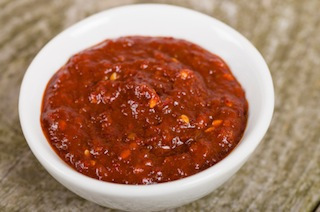 To your friends, family, and co-workers, you’re the weird one for that crock of fermenting cabbage on your counter, the packets of kefir grains you’re always giving away as gifts, and the fact that you have a shovel designed specifically for digging kimchi fermentation holes in your backyard. In college, you had pinup posters of Sandor Katz and loved to binge drink not because you liked getting drunk but because you just really loved fermented beverages. You sometimes dash bottles of pickles to the grocery store floor in bitter rage if they were pickled with vinegar rather than lacto-fermented. You spike store bought yogurt with probiotic powder because it’s not tart enough for you. But worry not, my dear fermentation-obsessed reader, for you are in good company.
To your friends, family, and co-workers, you’re the weird one for that crock of fermenting cabbage on your counter, the packets of kefir grains you’re always giving away as gifts, and the fact that you have a shovel designed specifically for digging kimchi fermentation holes in your backyard. In college, you had pinup posters of Sandor Katz and loved to binge drink not because you liked getting drunk but because you just really loved fermented beverages. You sometimes dash bottles of pickles to the grocery store floor in bitter rage if they were pickled with vinegar rather than lacto-fermented. You spike store bought yogurt with probiotic powder because it’s not tart enough for you. But worry not, my dear fermentation-obsessed reader, for you are in good company.
Everyone ferments. Throughout history, across cultures, continents, remote islands – everyone’s fermenting almost everything. Especially in Asian cuisine, which features an incredible panoply of pungent, living, complex sauces.
Let’s take a look at some of the best, most important, and most nutritious fermented condiments (plus, some really strange stuff) from that part of the world. When it’s available, I’ll provide any nutritional benefits. When it’s not, you can still count on these condiments conferring at least a few beneficial effects beyond delicious taste; foods don’t stick around so long unless there’s something to them (and yeah, I’m sure there are exceptions, but you get my point – traditional foods tend to be part of the tradition for a reason). Some of these will be familiar, some won’t. All are worth a taste, though.
(While you might recoil at the inclusion of soy-based condiments, recall that fermenting soy inactivates many of its antinutrients. Plus, these are just condiments to be used sparingly, not as full fledged food groups. No one’s drinking shot glasses of soy sauce. Well, one guy drank a quart once and almost died. Let’s not do that.)
Fish Sauce
Fish is already, well, fishy. And you’re telling me it’s a good idea to leave said fish out for up to a year packed in salt until it breaks down into a mushy consistency that gives off a clear liquid and then add that liquid to foods – foods that you then willingly put into your mouth, chew, swallow, and digest?
Oh yes.
Fish sauce isn’t really all that fishy, even.
We associate fish sauce nowadays with Southeast Asian cuisine, especially Vietnamese and Thai, but fermented fish sauce got its start in ancient Greece and Rome. There it was a daily staple that was added to almost everything and prized for its medicinal qualities. Since fish sauce was and is made using the entire fish – head, bones, guts, skin, and flesh – it’s going to be rich in B-vitamins and minerals.
The recipe hasn’t changed much over the years. Salt, fish, pressure, and time. No water, just pure unadulterated essence of fermented fish. Most fish sauce, having just those simple ingredients, doesn’t even have an “Asian flair” to it if you can get past the mental associations we have from smelling it in Vietnamese noodle houses. Experiment with it, and not just in Asian-style dishes. A tablespoon with some butternut squash mashed with butter? Added to scrambled eggs? Used with lime juice and sesame oil to marinate beef liver (okay, that’s a typically Asian-style recipe)? You’d be surprised at the condiment’s versatility.
The very best fish sauce I’ve had is Red Boat, which is getting some good press as of late and can be found in Asian grocers or purchased online. I’d highly recommend keeping a bottle around. You can get real fancy and buy Blis Barrel-Aged fish sauce, which they make by fermenting Red Boat fish sauce in Blis maple syrup barrels for another 17 months.
Any health benefits?
Fish sauce can scavenge free radicals in a test tube setting and displays antioxidant activity, with some varieties having greater activity than others. It might also be helpful as a marinade to reduce peroxidation and harmful byproducts while cooking. Plus, compounds isolated from fish sauce may have mild anti-hypertensive effects on rats.
Shrimp Paste
A vital, pungent (seriously, the stuff will clear a room) component of many Thai curries, the best shrimp paste is made from salted krill allowed to disintegrate into fermented mush. Lower quality paste is made from larger shrimp. It’s either sold as bottled wet paste or dried into cakes. The Thai-style cakes are best; store them unrefrigerated and flake off a few teaspoons to stir fry in coconut oil for the beginnings of a lovely sauce.
When you shop for shrimp paste, look out for added ingredients like sugar, MSG, or vegetable oils. You just want shrimp and salt. The best shrimp paste is purchased directly from shrimping villages in Southeast Asia, as this great piece makes quite clear, but (most of) you will have to settle for whatever they stock near you. Ordering shrimp paste online is iffy because you often can’t get a good look at the ingredients.
Any health benefits?
Shrimp paste contains an Mk-7 (the same as natto) vitamin K2-producing bacterium (which may explain why shrimp paste has been shown to prevent dental erosion and harden softened enamel caused by acidic food) as well as thousands upon thousands of mineral-and-chitosan-rich shrimp shells degraded for your full absorption.
Worcestershire Sauce
Not just a weird bottle wrapped in paper hiding in the back of the pantry, Worcestershire sauce is actually a legitimate fermented condiment with South Asian roots. Legend has it that the British governor of colonial Bengal, India, had British chemists reverse-engineer it based on a traditional sauce from Bengal. The distinguishing ingredient of Worcestershire sauce is fermented anchovies. And yes, even the stuff sold in regular grocery stores these days contains real fermented anchovies.
Any health benefits?
None documented.
Gochujang, Doenjang, and Cheonggukjang
Gochujang is a fermented paste made of chili peppers, soybeans, rice, and salt that’s frequently used in Korean cooking to adorn meat, vegetables, and rice dishes or flavor stews and soups. It’s spicy and a little sweet. Be sure to look for the gochujang (also called kochujang) with rice, not wheat, and watch out for additives like HFCS.
Traditional doenjang is just soybeans and salt – no chilies, no rice. It’s simple, it’s effective, it’s a strong foundation for a number of Korean dishes.
Like the last two, cheonggukjang is a fermented soy paste used in Korean cuisine. The distinguishing factor is the bacteria used to ferment it: Bacillus subtilis, the same species that makes natto, makes cheonggukjang, giving the paste an interesting taste that might take some getting used to.
Any health benefits?
Gochujang may help overweight adults shed visceral fat and improve their blood lipids (by lowering triglycerides and ApoB levels), improve insulin sensitivity in type 2 diabetics, and normalize glucose homeostasis in diabetic rats with 90% of their pancreases removed (what a life, huh?).
As for doenjang, though most studies use animals, those animals seem to benefit from doenjang. They lose visceral fat and improve their kidney disease. Of course, 10 grams of doenjang a day was enough to reduce visceral fat and body weight in overweight adults, too.
Little research exists on cheonggukjang, but the fact that it’s fermented using the natto bacteria means it has vitamin K2. Indeed, under optimal conditions, cheonggukjang can have almost four times as much K2 as natto. Another study actually compared the in vitro anti-cancer effects of cheonggukjang, natto, and shiodouchi (another soybean product fermented with Bacillus subtilis) and found that cheonggukjang was the most effective.
Soy Sauce
Yep, again with the soy. Real soy sauce is naturally brewed/fermented. Look out for the acid-hydrolyzed soy protein sauce masquerading as real soy sauce.
I’ve gotten in trouble for this before, so I’ll make it clear this time: if you are celiac or have a sensitivity to gluten, choose tamari-style soy sauce (and make sure it says “gluten-free,” as some types of tamari just use less wheat than normal soy sauce). For the rest of us, I don’t think a few dabs of soy sauce will hurt. I’m normally quite sensitive to large doses of gluten – I can get away with a crust or two of bread with butter and that’s it – and regular soy sauce doesn’t bother me. But, again, if you have a negative response to soy sauce, use gluten-free tamari instead.
Any health benefits?
A review found that soy sauce improves digestion by increasing gastric juice secretion (good, since we typically have it with food), inhibits microbial growth, contains an anti-hypertensive component, displays anti-cancer qualities, and has “shoyuflavones” with anti-inflammatory effects. Soy sauce also contains polysaccharides that may increase iron absorption and reduce the symptoms of hay fever. Real, fermented soy sauce has an antioxidant profile easily outclassing red wine, with one study finding that a single meal containing soy sauce reduced oxidative stress, lowered diastolic blood pressure, and inhibited lipid peroxidation in adults.
Shiokara
Shiokara is a ferment of small pieces of marine creature meat swimming in the salted, fermented, pulverized viscera of the animal. Cuttlefish is the most common animal used for shiokara, but everything from sea urchin to oyster to salmon to tuna to sea cucumber can work. If it swims – or even just hangs out on rock or ship hull somewhere underwater – and it’s edible, they’ve probably used it for shiokara.
You might find shiokara on the shelf at your local Asian grocery, but I’d avoid those or look very carefully at the ingredients list. They often contain additives, sweeteners, and MSG. You’re better off getting shiokara at a good Japanese restaurant or making your own.
Any health benefits?
None documented, but fish innards are pretty nutrient-dense if you can stomach them.
So, anyone hungry? I know I am. I suggest you take a trip down to your local Asian grocery, peruse the aisles, comb the ingredients lists, and try out some new fermented sauces.
What’s your favorite Asian fermented sauce? Let me know in the comment section!
Have You Seen the New Primal Book? Discover The Hidden Plague and the Special Offer That Expires on Nov. 30

November 18, 2013
Dear Mark: Acid Load and Type 2 Diabetes, and the Safety of Homemade Baby Food
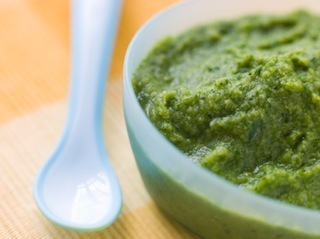 For today’s edition of Dear Mark, we’ve got a question about dietary acid load and type 2 diabetes. A new study’s just come out suggesting that the acid load of the diet does indeed have a significantly negative impact on our health and may actually cause type 2 diabetes. The reader is understandably worried, so I dig into the research and try to see what’s going on. Then, for Dear Carrie, my lovely wife answers a reader’s question about the safety of homemade baby food.
For today’s edition of Dear Mark, we’ve got a question about dietary acid load and type 2 diabetes. A new study’s just come out suggesting that the acid load of the diet does indeed have a significantly negative impact on our health and may actually cause type 2 diabetes. The reader is understandably worried, so I dig into the research and try to see what’s going on. Then, for Dear Carrie, my lovely wife answers a reader’s question about the safety of homemade baby food.
Mark,
I was under the impression that this was rubbished a long time ago provided you ate plenty vegetables? Unfortunately I can’t get hold of the full “The Times” article without subscribing but it was in the UK print edition. I thought you would be able to work your magic with journals to uncover what is really at work here.
Acidic Foods like Meat, Cheese and Soft Drinks Increase Diabetes Risk
Acids from meat and cheese are linked to higher diabetes risk
Regards,
Euan
Hey Euan, thanks for bringing this to my attention. I was able to find the full text of the study (PDF). It’s called “Dietary acid load and risk of type 2 diabetes: the E3N-EPIC cohort study” and tracks the type 2 diabetes incidence across 14 years among 66,000 French women.
So yeah, you could look at the results and claim that a high dietary acid load is associated with type 2 diabetes. That would be true. There is an association. The data is clear. But let’s look a little closer and see if there’s another way to consider the issue.
If you scroll on down to Table 1 in the study text, you’ll see the average intake of various macronutrients and food groups broken down by low, low-medium, medium-high, and high acid load quartiles. Intakes were very different across quartiles, particularly comparing the lowest and highest quartiles. Let’s look at some of them and consider how they might relate to the risk of diabetes:
The high-acid quartile ate the least magnesium. Magnesium intake has been strongly, consistently, and inversely linked to type 2 diabetes. A 2011 meta-analysis spanning 13 studies and over half a million subjects found a significant inverse association between magnesium intake and type 2 diabetes risk (in a dose response relationship, so the more they ate the less diabetes they got); an earlier meta-analysis had similar results. Just recently, a study found that higher magnesium intakes were associated with lower fasting glucose and insulin resistance, prompting the authors to posit that magnesium intake can protect against progression from pre-diabetes into full-blown type 2 diabetes. Another recent study confirmed these associations, finding that a high magnesium intake predicted reduced insulin resistance.
The high-acid quartile ate the least potassium. Potassium intake may be linked to type 2 diabetes as well, but it’s not clear. A recent review of the inconsistent evidence makes some interesting observations, however: induced hypokalemia (potassium deficiency) causes glucose intolerance in humans and repleting potassium reverses it.
The high-acid quartile ate the fewest vegetables. Although the evidence is somewhat unclear, vegetable intake is usually associated with a reduced risk of type 2 diabetes, particularly root vegetables and leafy greens. One study found that a great quantity and variety of vegetable intake led to a lower risk of type 2 diabetes. And once you have type 2 diabetes, green vegetable intake is associated with improved HbA1c scores and lower triglycerides. Plus, vegetables are the best source of protective nutrients like magnesium.
The high-acid quartile ate the fewest fruits. Certain fruits, particularly ones with antioxidant-rich skins like blueberries, plums, apples, and grapes, are associated with a reduced risk of type 2 diabetes despite the sugar content.
The high-acid quartile drank the least coffee – about half as much as the lowest quartile. Coffee is one of those consumables that everyone knows is bad for you but which is actually linked to a number of health benefits, most prominently a reduced risk of type 2 diabetes. Across study after study, habitual coffee consumption is consistently associated with less type 2 diabetes. They’ve even run randomized controlled trials where coffee consumption protected against glucose intolerance, one of the first signs of pre-diabetes. This is almost certainly a factor.
The high-acid quartile ate the most calories, and high calorie intake (or, put another way, energy excess) may increase the risk of type 2 diabetes (if it’s not accounted for by activity or basal metabolism) by inducing insulin resistance at the cellular level. They were also the least active of all quartiles, which would contribute to the energy excess.
Although this wasn’t listed in the nutrient intake table, the high-acid load quartile would have also consumed the fewest plant polyphenols and antioxidants due to lower fruit, vegetable, and coffee intake. Plant polyphenols have been shown to improve glucose tolerance and homeostasis, which may help prevent type 2 diabetes and partially explain the protective effect of fruits, vegetables, and coffee on metabolic health. Grape polyphenols, for example, prevent fructose-induced oxidative stress and insulin resistance.
So, is it the acid load causing (or preventing) the diabetes? Or is the acid load merely a representation of the diet which in turn causes (or prevents) the diabetes? Heck, it may even be that the diabetes is causing kidney disease, which in turn leads to acidosis. We don’t know for sure from this study. As the authors write in the discussion section, “this is the first prospective study to evaluate the risk of type 2 diabetes associated with scores reflecting the acid load of the diet.” What we do know is that many aspects of the overall dietary pattern of the high-acid quartile, like low magnesium, potassium, coffee, and produce intake, are consistently linked to type 2 diabetes across multiple studies. For now, that seems to be where the strongest evidence lies.
Eat your vegetables and fruits. Get your micronutrients and plant polyphenols. Drink your coffee. Try not to eat so much food that you gain weight and overload your cells’ ability to handle the energy. Exercise consistently and intelligently.
Dear Carrie: Is Homemade Baby Food Safe?
I actually do not have any children of my own… but as someone who is part of a local farm’s veggie & protein CSA, and is very passionate about “knowing where my food comes from”… this subject really disturbs me.
I’ve recently been warned via mass Facebook update about the risk of making baby food at home: “In 2005, the American Academy of Pediatric released their advisory for homemade baby food. They stated, ‘Infants fed commercially prepared infant foods generally are not at risk of nitrate poisoning. However, home-prepared infant foods from vegetables (eg, spinach, beets, green beans, squash, carrots) should be avoided…’”
Can you please provide your input? This seems like a marketing ploy… I can’t see how commercially prepared is better?
Thanks!!
Bethany
The worry with too much dietary nitrate in baby food is that it can lead to something called methemoglobinemia, or excess methemoglobin levels. Methemoglobin binds oxygen and prevents it from getting to the tissues in our body. In normal conditions, methemoglobin levels are extremely low and cause no problems. With too much nitrate in the baby’s diet, however, rapid conversion to nitrite in the immature intestines causes methemoglobin levels to jump 1000-fold, leading to tissue hypoxia (lack of oxygen). This is bad, particularly for a cute little helpless baby.
So, watch out for nitrates, right?
I found the Facebook post to be extremely misleading. I went ahead and took a look at what the AAP actually recommends. Nitrate only poses a problem for kids of a certain age. At six months, intestinal conversion from nitrate to nitrite is greatly reduced, making dietary nitrates much safer. It’s right there in what the AAP actually wrote back in 2005: “the intake of naturally occurring nitrates from foods such as green beans, carrots, squash, spinach, and beets can be as high as or higher than that from well water, these foods should be avoided before 3 months of age.” They go on to say that this shouldn’t be an issue anyway since “there is no nutritional indication to add complementary foods to the diet of the healthy term infant before 4 to 6 months of age.” Since you shouldn’t even be feeding complementary foods before 3 months, this isn’t a problem. In fact, I breastfed Devyn for two years and Kyle for a year. They were given only breast milk for the first six months of their lives.
Total non-issue, unless you know people who are pureeing these foods for their newborns under six months. That can be an issue. In a recent study looking at a group of homemade food-associated infant methemoglobinemia cases, the biggest risk factor was homemade food that was made too far in advance. Food made 24-48 hours before the kids ate it had an odds ratio of 17.4 and food made more than 48 hours before consumption had an OR of 24.9, most likely because the nitrate was converting to nitrite in storage (which, remember, is what does the damage). Other risk factors included breastfeeding (!), chard, and borage.
When I was introducing solid food to Devyn and Kyle, I usually made my own at home, (and vegetables were probably the last things I introduced). Even though I eat a ton of vegetables now, I do find many children tend to dislike vegetables, and you shouldn’t try to override their natural revulsion because it may be in place to keep them away from plant toxins they haven’t developed a defense for. It’s probably not a great idea to introduce chard, borage leaves, and spinach too early. Try meat, lightly cooked egg yolks, ripe fruit. My children enjoyed, peas, carrots and sweet potatoes. Those are way more digestible (and enjoyable). Besides, if you are feeding complementary foods, ones made at home are way more nutrient-dense than store-bought purees.
That’s it for today, folks. Let us know what you think in the comment board!
Order The Primal Blueprint Starter Kit and Take Control of Your Health Today!

November 17, 2013
Weekend Link Love
 Research of the Week
Research of the WeekLots of chocolate love this week. First, a cacao-extract added to premade meals reduced oxidized LDL levels in middle-aged overweight/obese people. Second, cocoa flavanols have neurocognitive benefits, stimulating blood flow in the brain, promoting neural connectivity and neurogenesis, and improving resistance to neurodegeneration. Translation: eat dark chocolate.
When you lift heavy things, sacrifice weight (and, perhaps, ego) before compromising on range of motion. A new study confirms that performing movements with full range of motion and lower weight builds more size and strength than going heavier with a lower range of motion. Word of caution: one should never compromise safety, form, and technique for the sake of range of motion. Don’t squat ass to grass if you have to displace a vertebrae to do it.
Interesting Blog Posts
There’s nothing I like more than an utterly unrepentant former vegetarian (who only did it for Morrissey in the first place) gone Primal. Check out Leeann’s story here – it’s a great read.
Dr. Ron’s take on the new cholesterol guidelines: they’re not as bad as you might think (and overall, it may even be a positive shift).
Speaking of Dr. Ron, his upcoming book The South Asian Solution is being published by Primal Blueprint Publishing early next year. It’s an important book that I think many MDA readers will really appreciate. In it he teaches readers how to interpret their cholesterol numbers and provides useful strategies that have helped his patients get off cholesterol medications. He also discusses the intrinsic flaws with the new cholesterol guidelines, provides a more global approach to risk assessment and cholesterol control addressing all ethnic groups rather than using the Framingham, Massachusetts white person’s risk calculator which repeatedly misses heart disease in high risk, insulin resistant patients, and discusses the role of advanced cholesterol tests (advanced lipid tests, CRP, EBCT, etc.) and how he has used these in his practice to avoid statins in patients who don’t need them. Check back and learn more mid-January, 2014.
Is protein satiating mostly because it tends to displace carbs?
Media, Schmedia
Nature is a powerful teacher, indeed.
Rickets is on the rise in the UK because kids are staying indoors too much (and we’re not even getting any economy-boosting child labor out of it).
Satire or Serious?
Moms, if you’re not covering your kids with sunscreen all day, every single day of the year, you are incredibly irresponsible because they are going to get a “bad sunburn and ultimately cancer as an adult.”
Everything Else
The Moscow subway has a new vending machine that has you complete 30 squats in two minutes and ride for free. The catch is if your lumbar rounds or you don’t break parallel, you have to pay up. Harsh, but preferable to the first prototype’s penalty: a polonium-soaked pin that emerges from the base to prick your heel.
A guy who invented inexpensive window inserts that do the job of storm windows is now making inserts that keep any outside light out – specifically for paleo-minded consumers who want to sleep in total darkness.
Forget guesswork. If it receives sufficient funding, the SunFriend wearable gadget promises to keep you apprised of how much UVB light you’ve received throughout the day and let you know – depending on your skin color – when you’ve made sufficient vitamin D.
Statistical significance isn’t necessarily all that significant.
What to do when agriculture stops working and you still want to grow stuff.
Recipe Corner
I’ve always preferred a good strong, dense shallot to oversized onions. Now, here’s how to really caramelize them.
Primal bacon chicken liver pate. Beautiful photos and a simple recipe yielding delicious, nutrient-dense results.
Time Capsule
One year ago (Nov 17 – Nov 23)
10 Healthier Ways to Spend Black Friday – Wading through the flood of humanity that coalesces around Black Friday may be a great physical workout, but it’s not exactly healthy.
Alcohol: The Good and the Bad – ‘Tis the season where alcohol abounds. Here’s what you need to know to make a good decision when faced with proffered beverages.
Comment of the Week
Mark, thanks for the detailed info although I’m having trouble reading the entire post because the mid-day sun here in So. Cal is causing too much glare and I keep dripping water onto my Kindle after I get out of the pool. I’m trying to keep up a good attitude but sometimes it’s tough, ya’ know?
- Indeed. It’s a tough life down here, and people don’t even know it.
Have You Seen the New Primal Book? Discover The Hidden Plague and the Special Offer That Expires on Nov. 30

November 16, 2013
Bacon Pancakes
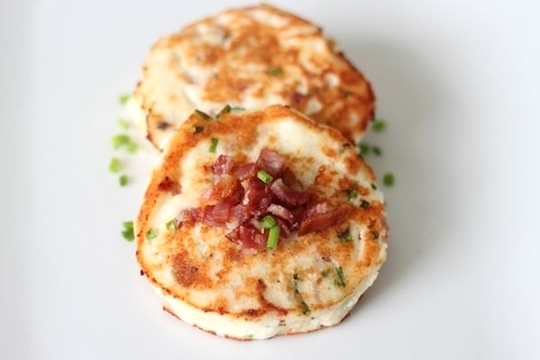 Bacon pancakes sound like a sinful breakfast treat, but these slightly sweet, mostly savory cakes require no repentance. Fluffy, moist and salty with just hint of sweetness, bacon pancakes can be served with a light drizzle of maple syrup, or a dollop of sour cream and a hit of hot sauce.
Bacon pancakes sound like a sinful breakfast treat, but these slightly sweet, mostly savory cakes require no repentance. Fluffy, moist and salty with just hint of sweetness, bacon pancakes can be served with a light drizzle of maple syrup, or a dollop of sour cream and a hit of hot sauce.
Peruse the list of ingredients for these Primal pancakes and you’ll see the usual suspects (coconut flour, eggs, butter) mixed with bacon and chives. But this recipe also has something completely new: gelatin. Why add gelatin to pancakes? Because you can, without affecting the flavor or texture.
Anecdotally, gelatin can benefit bone, joint and skin health and improve sleep quality. This recipe shows how easy it is to work unflavored gelatin into your diet. Add granular gelatin to other types of Primal pancakes and baked goods, soups and stews, meatloaf, smoothies, whatever. (Ideally, dissolve the gelatin in a little water or other liquid when adding it to a recipe).
But let’s get back to these delicious bacon pancakes. Serve them in a stack, or use two as buns for an egg and sausage breakfast sandwich. You really can’t go wrong.
Servings: 2 (6 small pancakes)
Time in the Kitchen: 30 minutes
Ingredients:

6 slices of bacon
3 egg whites*
1/4 cup coconut flour (30 g)
1 tablespoon purified granular gelatin (like this) (15 ml)
2 tablespoons unsalted butter, melted (30 ml)
2 tablespoons finely chopped chives (30 ml)
1/2 cup water (120 ml)
Instructions:
Cook the bacon in a frying pan over medium heat. Leave the bacon fat in the pan. Crumble or finely chop the bacon and set aside.

Whisk egg whites into soft peaks (an electric mixer works well for this). Set aside.
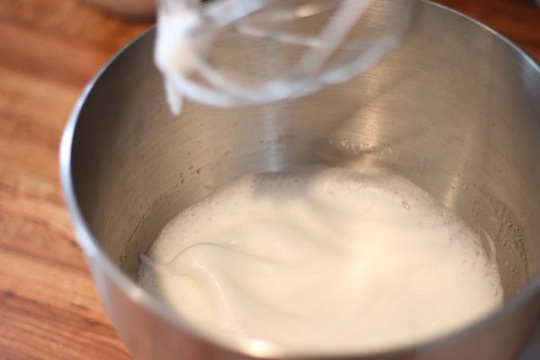
In a large bowl mix together the coconut flour, gelatin, butter, chives and bacon. Add the water and mix well then gently fold in the egg whites until combined. The batter will be thick and lumpy.

Re-heat the bacon fat in the frying pan over medium heat. Scoop small amounts (about 2 tablespoons) of batter into the pan, gently smoothing the batter out with a spoon to form small pancakes. Better yet, set a 3-inch biscuit cutter in the frying pan, drop the batter in the middle and then smooth out the batter to form perfectly round cakes.
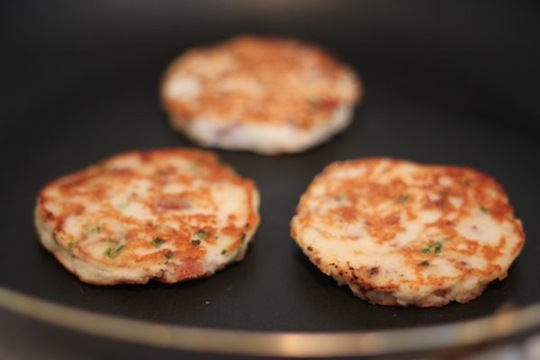
Cook about 3 minutes on each side. Serve warm.
*Using the entire egg instead of just the whites can be done but it makes a heavier, less fluffy pancake

Not Sure What to Eat? Get the Primal Blueprint Meal Plan for Shopping Lists and Recipes Delivered Directly to Your Inbox Each Week

November 15, 2013
I Am Strong, Energized, Off All Medications, and Feel Wonderful!
It’s Friday, everyone! And that means another Primal Blueprint Real Life Story from a Mark’s Daily Apple reader. If you have your own success story and would like to share it with me and the Mark’s Daily Apple community please contact me here. I’ll continue to publish these each Friday as long as they keep coming in. Thank you for reading!
 Mark,
Mark,
In December 2009, I was 25 years old and weighed 210 lbs. I was obese for my 5’5″ frame, never felt well, and was popping handfuls of pills every day just to get by. I was taking 2 anti-depressants, anxiolytics, prescription sleeping pills, courses of Prilosec once or twice a month, acid-blocking pills or antacid tablets 1-3 times a day, anti-diarrhea pills several days a week, and I was constantly catching respiratory infections and frequently took courses of antibiotics. In fact, I was put on chronic antibiotics by a dermatologist to treat rosacea, acne, and a truly horrible condition known as hidradenitis suppurativa (acne inversa). I would take them for several weeks at a time until everything calmed down, but inevitably within a few weeks more I would end up with another debilitatingly painful HS boil and would need to start up the antibiotics again. I also got either a yeast infection or a urinary tract infection almost once a month (and sometimes both in the same month). I had dysmenorrhea and would typically miss one day of work per month due to my cycle. In the summer of 2008 I was diagnosed as pre-daibetic with metabolic syndrome and hypertension, so by the end of 2009 I was quite probably a full-fledged type II diabetic, I just never got an official diagnosis. I was falling apart mentally and physically, and scared to death of a miserable future full of multiple chronic illnesses and scary prescription medications, so I decided to make some drastic changes to my lifestyle. I resolved to do my research over the holidays and begin in 2010 with a new way of life.
I read up on all the conventional wisdom suggestions for weight loss, and believed in the now debunked theories of “a calorie is a calorie” (calories are all created equally, so just eat fewer of them and you’ll lose weight!) and “calories in, calories out” (just exercise to create a calorie deficit, you’ll lose weight!); that fat, especially saturated fat, was to be avoided at all costs; whole grains, especially whole wheat, were the ultimate health foods; meat should be avoided except for chicken breasts and fish, and meat replacement products are healthy sources of protein. I limited my portions, restricted calories, started up chronic cardio exercise (3-5x/week, 30-60 min at a time) with some machine work for strength training once or twice a week, too. My choice for cardio was running, because I couldn’t stand the idea of using some man-made machine for that purpose. Just like with the food recommendations, I followed conventional wisdom for purchasing the “best” running shoes. They were motion control and ultra-squishy (or as I like to call them, marshmallow shoes). They were designed to “correct” over-pronation and protect my body from the shock of repeatedly pounding my heels into the ground.
I kept up this new “healthy” eating and exercising routine for several months, and in that time I didn’t really see the scale budge (it would fluctuate down maybe 5-10 lbs but then creep up again) or notice my clothes fitting any better. But I sure did notice that I was hungry all the time, sore all the time, and almost felt worse than before I started! I felt so helpless and discouraged, and started to wonder if I would ever see any results.
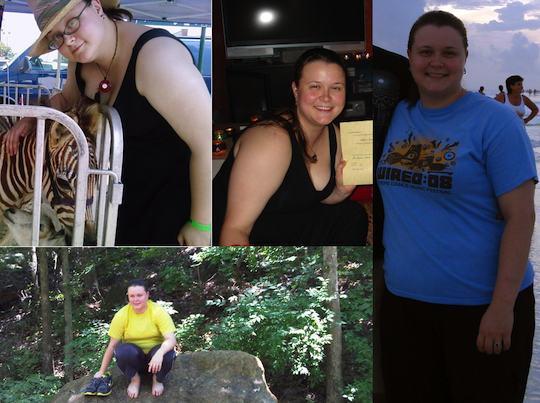
If you’ve ever done this kind of routine, you know – it is miserable ! No WONDER so many people who “go on a diet” and “start exercising” fail to achieve results or maintain the regimen for very long. It simply isn’t sustainable, and all of that exercise isn’t good for an overweight or obese body. I learned that the hard way: I hurt myself running. It turns out, though, that getting hurt was one of the best things that ever happened to me and ended up leading me to the Primal lifestyle.
I was so frustrated when I had to stop exercising. I felt so betrayed by the bad advice I had gotten about running and shoes, so I started seeking alternative advice. I searched for things like “how to run without injury,” “are motion control shoes necessary,” etc., and I found Danny Dreyer’s Chi Running, and soon thereafter Chris McDougall’s fabulous book Born to Run, and from there found Barefoot Ted’s Google group. I devoured all of the information I could on barefoot running and immediately converted. The mechanics of proper barefoot running made so much sense to me, as I had always walked with a forefoot strike when barefoot (I have vivid memories of being teased for this as a child, but I didn’t care, and continued with my “cat walking”, as I called it). I was a regular on the Google group, and one fateful day somebody posted a link to Mark’s Daily Apple.
I was completely blown away. Everything I thought I knew to be true about diet, health, and weight loss was all wrong. I spent the next few weeks reading as many articles as I could on the website and spending time in the forums asking questions. I cross-checked references and read what was published in the scientific literature at the time to verify that the site contained valid information. Ultimately, it was the success stories that gave me the final push to try it myself. All of this coincided perfectly with the September 2010 30-day Primal Blueprint Challenge, which is when I took the plunge (albeit a few days late, due to travel), and I haven’t looked back since.
I lost 10 lbs and 2 inches off my waist in the first 12 days. By 1 month I was down 15 lbs and went from my pre-Primal size of 18 down to a 12. The weight continued to fly off after that. I didn’t keep super careful records of all my milestones, but by 1 year I was 80 lbs lighter (130 lbs) and in a size 6 and sometimes a 4. Just after my 2 year anniversary, I was pretty much the same weight but leaner and smaller, generally wearing size 2 or 4 but sometimes a 6, depending on the brand. Now, just after my 3 year anniversary, I actually weigh in at 140 lbs but I’m still wearing sizes 2-6 (and the same clothes I was wearing a year ago). I’ve added lots more body weight exercise to my routine and am definitely stronger. Also, I have also had an increase in breast size. I’m not exactly sure what to attribute this to, but I think it’s due to some positive hormonal changes, because I now typically have zero negative symptoms associated with my monthly cycle. While I saw huge improvements in this area shortly after going Primal, I would still occasionally have a bad one (although it was mild in comparison to pre-Primal – I stopped missing work over it!) So, despite weighing a bit more, I’m still the same dress size, and the weight is due to some muscle gain and breast size increase (can’t complain about either!). As I continue to progress, I expect to gain more weight (as lean mass) while my dress size stays the same or decreases.
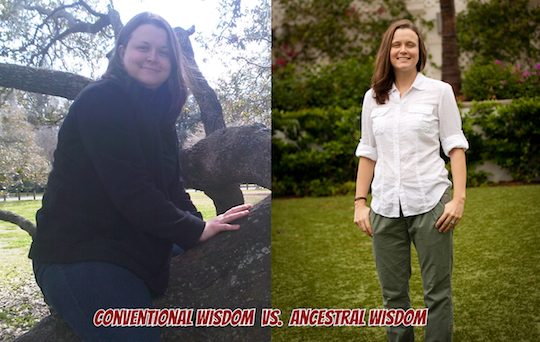
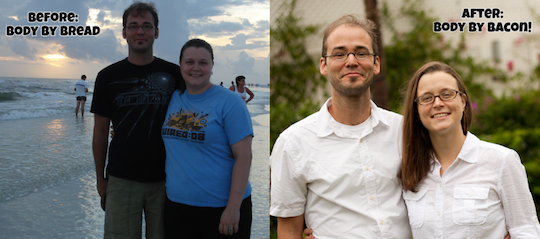
Regarding my health, I noticed tremendous alleviation of my multiple gastrointestinal ailments within just a few days of being Primal. I never realized how used to feeling bloated I had gotten – it felt so wonderful to have a calm tummy! By the end of the first week, I no longer needed my antacids and acid-blockers. Within a few days I also noticed incredible new mental clarity, improved mood, lower anxiety, and improved sleep. I stopped getting acne outbreaks, and best of all: I had immediate relief from hidradenitis suppurativa, and eventually enjoyed remission of the condition. My blood pressure normalized and I regained insulin sensitivity.
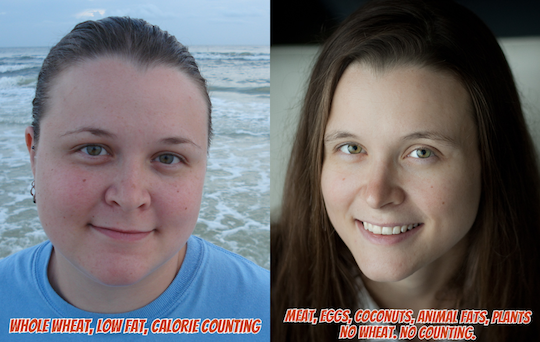
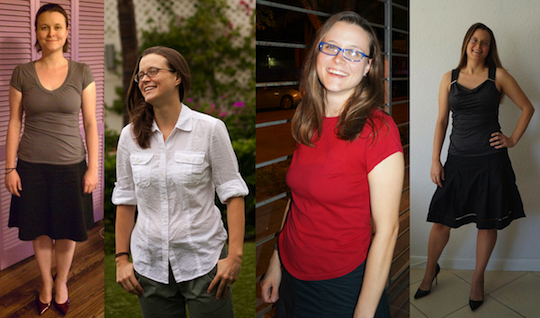
In middle and high school, I was always between 115-130 lbs, but I was anywhere from a size 6-10. I now realize I was always “thin fat”: so-called normal weight but very flabby and weak. I have also always had low self-esteem and been very critical of my body, even before I became obese. Finally, I am able to feel confident and beautiful despite my flaws (losing 80 lbs of fat does a number on your skin), and I am strong, energized, off all medications, have reversed all of my pre-Primal ailments, and feel wonderful! From the bottom of my heart, thanks Mark!
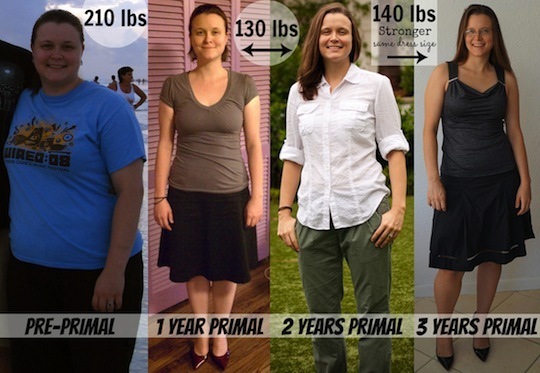
Best,
Amanda T.
Read Amanda’s full story on her blog The Curious Coconut
Have You Seen the New Primal Book? Discover The Hidden Plague and the Special Offer That Expires on Nov. 30

Mark Sisson's Blog
- Mark Sisson's profile
- 199 followers



